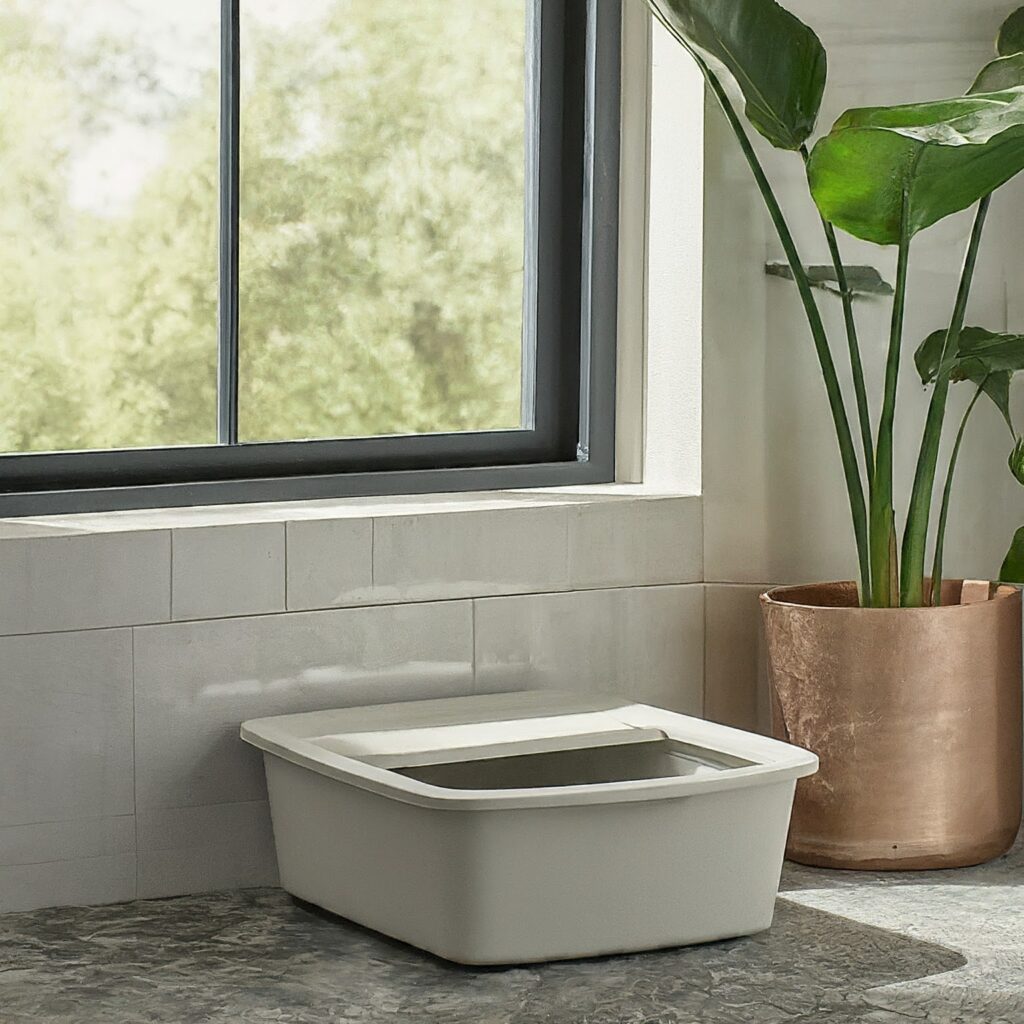
If you’re struggling with how to get cat to use litter robot, you’re not alone. Many cats refuse at first because they don’t like change. The good news is that with patience, simple training, and the right setup, most cats will learn to use a litter robot within a few days to a few weeks.
Why do cats resist? Cats are creatures of habit. They may be scared of the new shape, the sound, or the smell. But once they get comfortable, a litter robot makes life easier for both you and your furry friend. Stay with us for the long haul. I have brought you a lot of interesting things.
Table of Contents
Why Cats Resist Automatic Litter Boxes

Many cat parents buy the Litter Robot thinking it will instantly solve cleaning struggles, only to find their cat avoiding it. But don’t worry—this is common. Understanding why cats resist can help you identify and resolve the problem. Cats are creatures of habit, and any change in their litter box setup can feel like a threat to their routine. Below are the main reasons your cat may hesitate:
1. The Noise Factor
Automatic litter systems, such as the Litter Robot, make mechanical sounds when in operation. While humans know this means cleaning, cats may find it scary. Especially timid cats or rescues may see it as a “predator-like” sound.
Reader wants to know: How long does it take cats to get used to the noise? (Answer: Usually 1–2 weeks, but some need longer. Keep it unplugged at first until your cat feels safe.)
2. Size and Shape Changes
Traditional pans for cat litter are open and familiar. The Litter Robot is larger, enclosed, and shaped like a pod. Some cats feel trapped or unsure about stepping inside.
Reader wants to know: Is the Litter Robot too small or too big for my cat? (Answer: Most cats adapt, but very large breeds like Maine Coons might feel cramped.)
3. Scent and Substrate Issues
Cats are very sensitive to smells and textures. If you suddenly swap their old cat litter for a new brand when setting up the Litter Robot, your cat may reject it.
Reader wants to know: Can I use any litter in the Litter Robot? (Answer: Use a fine-clumping litter your cat already trusts before switching brands. Familiar scent helps transition.)
4. Loss of Territory
Cats view the litter box as part of their territory. Replacing it with a new automatic system can feel like losing control. Some cats resist as a way of reclaiming their space.
Reader wants to know: Why is my cat pooping outside the Litter Robot? (Answer: It’s often territorial stress. Try keeping the old litter box nearby until your cat fully transitions.)
5. Negative First Experience
If a cat tries the Litter Robot once, gets startled by movement, or slips inside, they may form a negative association. This is one of the biggest reasons cats stop using it.
Reader wants to know: How do I retrain my cat if this happens? (Answer: Go back a step—keep the Robot turned off, reward your cat for exploring it, and slowly reintroduce it.)
Key Takeaway for Readers
Cats don’t resist because they dislike the Litter Robot itself—they resist because it’s different. By identifying the specific reason (noise, smell, territory, or fear), you can tailor your approach and finally solve the problem of how to get cat to use litter robot.
Choosing the Right Litter Robot Model
One big reason cat owners struggle with how to get cat to use litter robot is that they picked the wrong model for their cat’s needs. Not every cat is the same—kittens, seniors, and multi-cat households all require different setups. Choosing wisely can save you from behavior issues, accidents, and wasted money.
Here’s what readers (and Google searchers) are looking for when deciding on a Litter Robot model:
1. Size and Cat Comfort
Cats are picky about space. If the unit feels too small or too enclosed, they’ll resist.
- Litter Robot 3 → Best for average cats (8–15 lbs).
- Litter Robot 4 → Bigger entry and interior, ideal for large breeds (Maine Coon, Ragdoll) or multi-cat homes.
Reader wants to know: Which Litter Robot is best for big cats?
Answer: The Litter Robot 4 has more room, making it easier for larger cats to enter and feel secure.
2. Noise Levels
Cats often resist because of loud cycles. If your pet is noise-sensitive, this matters.
- Older Litter Robot models may sound mechanical.
- Litter Robot 4 has quieter technology, making transitions smoother.
Reader wants to know: Is the Litter Robot noisy?
Answer: The new Litter Robot 4 is almost silent compared to older versions, which helps with shy cats.
3. Multi-Cat Features
Households with more than one cat need faster cycling and bigger waste drawers.
- Litter Robot 3 Connect → Handles 2 cats comfortably.
- Litter Robot 4 → Designed for 3–4 cats with faster cycling and odor control.
Reader wants to know: Can multiple cats share one Litter Robot?
Answer: Yes, but for more than 2 cats, upgrade to the Litter Robot 4 for efficiency.
4. Smart Technology & App Control
Modern cat parents in 2025 love smart home integration. The Litter Robot app tracks usage, waste drawer levels, and even helps monitor your cat’s health.
Reader wants to know: Why do I need the app?
Answer: The app helps track patterns like how often your cat uses the litter box, which can signal early health problems (UTIs, constipation, stress).
5. Price vs. Value
A Litter Robot is an investment. Readers want to know if the extra cost is worth it.
- Budget-conscious owners → Litter Robot 3 is cheaper but lacks newer quiet-cycle features.
- Future-proof choice → Litter Robot 4 costs more upfront but saves on maintenance and stress.
Reader wants to know: Is the Litter Robot worth it?
Answer: Yes, especially if you struggle with cleaning multiple cat litter pans daily. It saves time, reduces odor, and helps cats stay consistent with bathroom habits.
Key Takeaway for Readers
Choosing the right Litter Robot isn’t just about price—it’s about matching the model to your cat’s needs. The wrong choice can make it harder to solve how to get cat to use litter robot, while the right model makes the transition smoother, quieter, and stress-free.
Step-by-Step Training Plan
Training your cat to love the Litter Robot doesn’t happen overnight. Cats are routine-driven, and sudden changes can cause stress. A slow, structured plan is the best way to solve the problem of how to get cat to use litter robot without accidents or resistance.
Here’s a proven 7-day transition plan that thousands of cat parents follow successfully:
Day 1–2: Introduction Without Pressure
- Place the Litter Robot in the same room as your cat’s old litter box.
- Keep the Robot unplugged so it doesn’t move or make noise.
- Allow your cat to sniff, explore, and get used to the shape.
- Sprinkle a small amount of your cat’s used cat litter inside so it smells familiar.
Reader wants to know: Why keep it unplugged at first?
Answer: Movement can scare your cat before they feel safe inside.
Day 3–4: Side-by-Side Setup
- Keep both the old litter box and the Litter Robot available.
- Slowly reduce the amount of cat litter in the old box while keeping the Robot full.
- Reward your cat with treats or gentle praise whenever they step into the Litter Robot.
Reader wants to know: How long should I keep both boxes out?
Answer: Until your cat uses the Robot at least once confidently.
Day 5: Encouragement with Rewards
- Turn on the Litter Robot, but only let it cycle when your cat isn’t nearby.
- Encourage your cat to use it by placing treats near the entrance or inside.
- Use calming aids like Feliway spray if your cat is nervous.
Reader wants to know: What if my cat still won’t go inside?
Answer: Place their waste from the old box inside the Robot so they recognise it as their toilet.
Day 6: Gradual Removal of Old Box
- By now, your cat should be testing the Litter Robot.
- Remove the old litter box completely or move it to another room as a backup.
- Monitor closely—if accidents happen, don’t punish. Instead, guide your cat back to the Robot.
Reader wants to know: Why can’t I just remove the old box right away?
Answer: Cats need gradual change. Removing it too soon may cause “revenge peeing” or accidents.
Day 7: Full Transition
- Keep only the Litter Robot in place.
- Maintain a clean cycle schedule (cats won’t use dirty boxes).
- Continue rewarding your cat for every successful use.
Reader wants to know: When will my cat be fully comfortable?
Answer: Most cats adapt within a week, but shy cats may take 2–3 weeks. Stay patient.
Key Takeaway for Readers
Training is not about forcing—it’s about building trust. If you follow this day-by-day plan, your cat will naturally learn how to get cat to use litter robot without fear or stress.
Pro Tips to Speed Up Adaptation
Even with a step-by-step plan, some cats take longer to adjust. If you’re eager to shorten the transition and finally solve how to get cat to use litter robot, these expert-backed strategies can help.
1. Use Familiar Cat Litter First
Never switch litter brands at the same time you introduce a Litter Robot. Keep the same cat litter your cat already trusts. Once they’re fully adapted, you can try other recommended clumping brands.
Reader wants to know: Can I use crystal litter or pellets in the Litter Robot?
Answer: Stick with fine, clumping litter—this keeps cats comfortable and ensures smooth cycling.
2. Reward Every Success
Positive reinforcement works wonders. Each time your cat steps inside or uses the Litter Robot, reward them with:
- Treats
- Playtime with a favorite toy
- Gentle praise or petting
Reader wants to know: Why are rewards important?
Answer: Cats learn through positive associations. Rewards build trust faster than forcing.
3. Keep the Robot Extra Clean
Cats are clean freaks. If the unit smells or has waste buildup, they may reject it. Empty the drawer regularly and clean the globe weekly.
Reader wants to know: How often should I clean the Litter Robot?
Answer: The drawer usually needs emptying every 5–7 days for one cat, but check sooner in multi-cat homes.
4. Control the Noise
If your cat is timid, keep the Litter Robot unplugged for the first few days. Once they’re comfortable, plug it in but supervise the first cycle so your cat sees it’s safe.
Reader wants to know: Is the Litter Robot safe for cats during cycling?
Answer: Yes, it has safety sensors that stop rotation if a cat enters.
5. Use Calming Aids if Needed
For especially anxious cats, try:
- Feliway spray or diffuser near the litter box
- A soft blanket with your scent near the Litter Robot
- Slow introductions with doors open, no pressure
6. Leverage Multiple Entry Points
If you have multiple cats, place one Litter Robot in a shared space and another in a quiet corner. This reduces territorial disputes and ensures everyone adapts faster.
Pro Insight:
The Litter Robot is one of The Best Automatic Cat Litter Box options available today—but only if your cat actually uses it. Speeding up adaptation isn’t about pushing—it’s about making the Robot feel safe, rewarding, and clean. With these pro tips, you’ll reduce stress, avoid accidents, and quickly solve the challenge of how to get cat to use litter robot.
Troubleshooting – If Your Cat Still Refuses
Even after following a slow transition plan, some cats still won’t use the Litter Robot. Don’t panic—this doesn’t mean you’ve wasted money. It just means your cat needs a little extra troubleshooting. Here are the most common reasons cats resist and what you can do to fix them.
1. Fear of Movement or Noise
Some cats are more sensitive than others. If your cat is scared of the cycling sound, unplug the unit for a full week. Let your cat use it as a static litter box first, then gradually reintroduce the automatic function.
Reader wants to know: What if my cat jumps out when it starts cycling?
Answer: Turn off cycling until they are confident. Cats adapt faster when they feel safe.
2. Negative Association
If your cat tried the Litter Robot once and got startled, they may associate it with stress. To fix this:
- Move it to a neutral location.
- Add familiar cat litter inside.
- Place treats or toys near the entry.
- Use calming pheromones around the area.
3. Territorial or Multi-Cat Stress
In multi-cat homes, one cat may guard the Litter Robot, stopping others from using it. Cats see the box as territory.
Reader wants to know: Should I get more than one unit?
Answer: Yes, the rule of thumb is one litter box per cat, plus one extra. If you only have one Litter Robot, add another option until tensions ease.
4. Wrong Location
Cats want privacy, quiet, and no surprises when they go. If the Litter Robot is near loud appliances (washer, dryer) or heavy foot traffic, your cat may reject it.
Move it to a low-stress area where your cat already feels safe.
5. Medical or Behavioral Issues
Sometimes the issue isn’t the Litter Robot at all—it’s your cat’s health. If your cat suddenly stops using any litter box, it could signal:
- Urinary tract infection (UTI)
- Constipation
- Stress or anxiety
- Arthritis (difficulty climbing inside)
Reader wants to know: How do I know if it’s medical?
Answer: If your cat avoids all litter setups and shows signs like straining, blood, or crying, see a vet immediately.
6. Try a Reset Method
If all else fails:
- Reintroduce your old litter box side by side.
- Let your cat rebuild trust in a familiar space.
- Slowly taper the old box away once they start testing the Litter Robot again.
Key Takeaway for Readers
If your cat still refuses, it’s not the end of the road. Solving how to get cat to use litter robot means identifying whether the issue is noise, territory, location, or health. With patience and troubleshooting, even stubborn cats eventually adapt.
Health & Hygiene Tips for Litter Robot Owners
Owning a Litter Robot makes life easier, but keeping it clean and safe is just as important as getting your cat to use it. Good hygiene not only prevents odor but also protects your cat’s health. Many readers looking for how to get cat to use litter robot also want to know: “How do I keep it sanitary and odor-free?”. Here’s what matters most.
1. Empty the Waste Drawer on Time
The Litter Robot has a drawer that collects waste, but waiting too long to empty it can create strong smells and discourage your cat from using it.
Reader wants to know: How often should I empty the drawer?
Answer: For one cat, every 5–7 days. In multi-cat homes, check every 2–3 days.
2. Deep Clean the Globe Monthly
Even though the Litter Robot cycles automatically, residue builds up over time. Wash the globe with mild, pet-safe soap and warm water once a month. Avoid strong chemicals that may leave scents cats dislike.
3. Stick With the Right Cat Litter
Not all litters work equally well. Fine, clumping cat litter is best because it reduces tracking, controls odor, and helps the unit cycle properly. Avoid heavy pellets or non-clumping types.
Reader wants to know: Can scented litter cause problems?
Answer: Yes, strong scents can drive cats away. Stick to unscented clumping litter.
4. Check for Health Red Flags in Waste
One hidden benefit of the Litter Robot is tracking your cat’s bathroom habits. If you notice:
- More frequent urination → possible UTI or diabetes.
- Less frequent poop → possible constipation.
- Blood or mucus → urgent vet check.
Reader wants to know: Can the Litter Robot track my cat’s health?
Answer: Yes, newer models like the Litter Robot 4 connect to an app that logs usage patterns.
5. Keep the Surrounding Area Clean
Cats don’t like mess near their bathroom. Vacuum litter scattered around the litter box area, and use a mat to trap stray particles. This keeps paws clean and prevents tracking across your home.
6. Prevent Odor Naturally
Use baking soda or carbon filters in the drawer to absorb smells. Regular cleaning keeps the environment fresh and encourages your cat to keep using the Litter Robot.
Key Takeaway for Readers
Maintaining the Litter Robot isn’t hard, but consistency is key. Clean equipment, the right cat litter, and odor control all keep your cat healthy and motivated. Hygiene is just as important as training when it comes to how to get cat to use litter robot successfully.
Cost & Maintenance Breakdown
Is a litter robot worth the price? Let’s compare:
- Upfront Cost – $500–$700 (depending on model).
- Maintenance Costs – Liners, filters, electricity = about $10–15 per month.
- Lifetime – 3–5 years average.
- Savings – Less scooping, fewer odors, more convenience.
For busy owners, the litter robot pays off in time saved.
Alternatives if Training Fails
If your cat still refuses, don’t panic. You have options:
- Semi-automatic litter systems.
- Covered boxes for odor control.
- Hybrid setups (one litter robot + one traditional box).
This gives stubborn cats time to adjust without stress.
Recomended products for litter robot
If you’re working on how to get cat to use litter robot, the right accessories and add-ons can make the transition smoother, cleaner, and healthier for your cat.
1. Litter Robot Fence Attachment
- Prevents litter scatter when cats exit.
- Helps nervous cats feel more secure while stepping in and out.
2. Litter Robot Carbon Filters
- Neutralizes odors in the waste drawer.
- Essential for hygiene and to keep cats using the unit consistently.
3. Litter Trapper Mat
- Traps stray cat litter before it spreads across your home.
- Keeps the litter box area neat and paw-friendly.
4. Unscented Clumping Cat Litter
- Cats prefer unscented options.
- Works best with the automatic sifting system.
5. Litter Robot Ramp
Prevents joint strain and helps timid cats feel safe. Ideal for senior cats or kittens who need easier access.
FAQs-How to Get Cat to Use Litter Robot
What to do if my cat won’t use the Litter-Robot?
Start slow. Place the litter robot near the old box, mix old litter inside, and use treats to encourage.
How to get your cat used to Litter-Robot?
Give them time, use familiar litter, keep the robot off at first, and reward each step.
How to get a scared cat to use a Litter-Robot?
For anxious cats, place it in a quiet spot, use pheromone sprays, and let them hear the cycle from a safe distance.
Why is my cat not triggering Litter-Robot?
Cats under 5 pounds may be too light for sensors. Also, check if litter level is correct.
Why is my cat pooping on the floor instead of Litter-Robot?
Cats may dislike the entry height, the noise, or the litter texture. Try lowering entry or changing litter.
Do some cats not like litter robots?
Yes, a small number of cats never adapt. For them, semi-automatic or traditional boxes may work better.
Further readings
Nature’s miracle corn cob litter review
Wrapping up
Training your cat to use an automatic litter box may feel challenging at first, but with patience, the right model, and a step-by-step plan, most cats eventually adapt. Remember, cats are creatures of habit—they need time, comfort, and consistency before they accept new changes in their routine.
By following the day-by-day training guide, applying pro tips to speed up adaptation, and troubleshooting problems along the way, you’ll be well on your path to success. More importantly, keeping the litter robot clean, odor-free, and comfortable ensures both better hygiene for your home and a stress-free environment for your cat.







